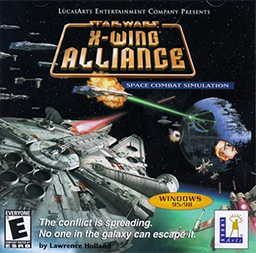
Star Wars: X-Wing Alliance is a space simulation video game, the sequel to both Star Wars: TIE Fighter and Star Wars: X-Wing vs. TIE Fighter. X-Wing Alliance presents the story of the Azzameen family, a family of space traders. The player assumes the role of Ace Azzameen, the youngest of the Azzameen children, juggling military duty as a fighter pilot for the Rebel Alliance, and allegiance to his family, flying larger heavily armed freighters for the family business, amid a bloody family feud and in the larger context of a galactic civil war. It received favorable reviews.
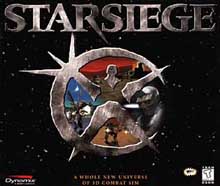
Starsiege is a mecha-style vehicle simulation game developed by Dynamix and released in 1999. Starsiege is set in the Metaltech/Earthsiege universe, which contains its predecessors Earthsiege (1994), Battledrome (1994), and Earthsiege 2 (1996). This universe also includes action game Hunter Hunted (1996), strategy games Mission Force: Cyberstorm (1996) and Cyberstorm 2: Corporate Wars (1998). It also includes the sequelsStarsiege: Tribes and all subsequent Tribes titles. In 2015, this game and the rest of the Metaltech/Tribes series were released as freeware by Hi-Rez Studios, but Battledrome and the Cyberstorm series were not.
Rowan Software was a British software company focused on the development of computer games. The company was founded by Rod Hyde in 1987 and based in Runcorn, Cheshire. Rowan was best known as a publisher of flight simulators for the PC.

Red Baron II is a video game for the PC, developed by Dynamix and published by Sierra On-Line. It is the follow-up to the flight simulation Red Baron, released in 1990. Red Baron II was released in December 1997. A patch was released in 1998 that added support for 3D acceleration and renamed the game to Red Baron 3D. Red Baron 3D was also released as a retail product.

Return to Krondor is a role-playing video game set in Raymond Feist's fictional fantasy setting of Midkemia. A sequel to 1993's Betrayal at Krondor, it was released for Windows on the PC in time for the 1998 Thanksgiving and Christmas season. Within the game, the player commands a group of heroes with different attributes, strengths, and weaknesses which the player may upgrade over the course of the game.

AH-64D Longbow is a realistic combat flight simulator of the AH-64D Apache Longbow attack helicopter. Released on June 3, 1996, for the PC, this simulation was developed at Origin Systems. AH-64D Longbow was the second simulator released under the Jane's Combat Simulators line from Electronic Arts.

European Air War is a combat flight simulator developed and published by MicroProse and published for Microsoft Windows in 1998. It is a sequel to 1942: The Pacific Air War. It simulates the Battle of Britain, and the Allied Air offensives in Western Europe during World War II in 1943–1945.
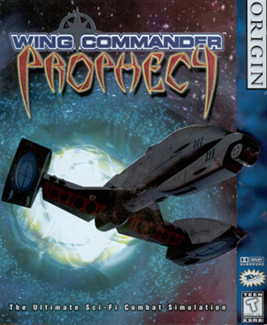
Wing Commander: Prophecy is the fifth installment in the Wing Commander science fiction space combat simulator franchise of computer games. The game was released in 1997 for Windows, produced by Origin Systems and distributed by Electronic Arts. In 2003, a Game Boy Advance conversion with added multiplayer was produced by Italy-based Raylight Studios and distributed by Destination Software.

MechWarrior 3 is a vehicle simulation game, part of the MechWarrior series. It featured a new 3D accelerated graphics engine at the time of its release. The game contains over 20 missions, with access to 18 different mechs. A novelization called Trial Under Fire was written by Loren L. Coleman.
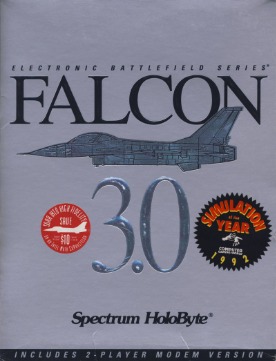
Falcon 3.0 is a combat flight simulator video game developed by Sphere Inc. and published by Spectrum HoloByte in 1991 as third official main entry in the Falcon series of the F-16 Fighting Falcon simulators.

Jane's World War II Fighters is the 1998 combat flight simulation video game. Set in the European theatre of operations during World War II, it is part of the Jane's Combat Simulations franchise. The game was considered a commercial failure, and contributed to the end of the Jane's Combat Simulations line.

Rowan's Battle of Britain, sometimes known simply as Battle of Britain, is a World War II era combat flight simulation game set during the Battle of Britain in 1940.

Jane's USAF: United States Air Force is a combat flight simulation video game developed by Israeli studio Pixel Multimedia and released in 1999 as part of Jane's Combat Simulations series. The game is set from the late 1960s to the early 2000s and it is a jet aircraft survey simulation featuring satellite imagery for terrain which allowed quite detailed graphics for the time of the release of Jane's USAF. The game features four campaigns: the Vietnam War, Persian Gulf War, and two fictional campaigns, one based on the Red Flag exercises and one depicting a war between NATO and Russia over Germany in the then-future of 2005. Also included are single missions, with maps from the Middle East to Korea. Training missions include take-off, landing, and refuelling in Nellis Air Force Base.

Enemy Engaged: Comanche vs Hokum, also known as simply Enemy Engaged or abbreviated EECH, is an attack helicopter combat flight simulator video game developed by Razorworks and released by Empire Interactive for Windows and macOS in 2000.

Jane's F-15, also known as simply F-15, is a combat flight simulator video game developed and released by Electronic Arts in 1998 for the PC. It models the McDonnell Douglas F-15E Strike Eagle. EA's 2000 Jane's F/A-18 used an improved version of F-15's game engine.

Longbow 2 is the sequel to Jane's AH-64D Longbow from Jane's Combat Simulations. The game was developed by Origin Systems with executive producer Andy Hollis on board, and released by Electronic Arts on November 13, 1997.
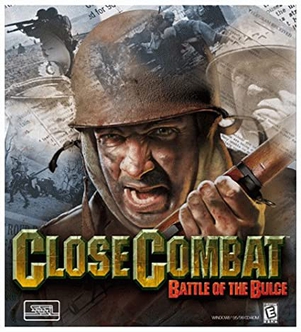
Close Combat: Battle of the Bulge, sometimes known as Close Combat IV: Battle of the Bulge, is a 1999 computer wargame developed by Atomic Games and published by Strategic Simulations Inc. (SSI). A simulation of the Battle of the Bulge during World War II, it is the fourth game in the Close Combat series. A remake, Close Combat: Wacht am Rhein, was released in 2008.

F1 Racing Simulation is a racing simulation game, developed for Microsoft Windows by Ubisoft in 1997. The game is based on the 1996 Formula One World Championship, and is the first of the Racing Simulation games made by Ubisoft, being the predecessor to Racing Simulation 2, which was released in 1998.
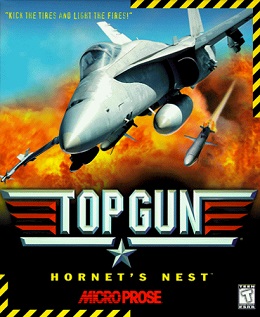
Top Gun: Hornet's Nest is a 1998 combat flight simulation game developed by Zipper Interactive and published by MicroProse for Microsoft Windows. It is loosely based on the 1986 film Top Gun, and is a sequel to the 1996 game Top Gun: Fire at Will. The game was criticized for its lack of realism and its flight physics.
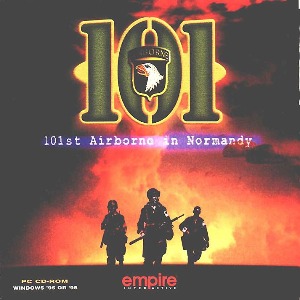
101: The Airborne Invasion of Normandy is a 1998 computer wargame developed by Interactive Simulations and published by Empire Interactive. Key members of the team had previously worked at Random Games, developer of Soldiers at War and Wages of War.



















